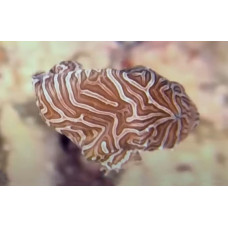Latin name
Histiophryne psychedelica
Other names
Histiophryne psychedelica
Identification
The skin is flaccid and fleshy, without scales, secreting mucus, and covered with many wrinkles for protection from sharp coral rays. The skin also covers the dorsal and lateral fins. Unlike most other anglers Histiophryne psychedelica lacks an illichium and has a reduced mouth. The snout of Histiophryne psychedelica is flattened, with the cheeks and chin extended laterally. The fish is able to extend its head and mouth forward, giving the body the more elongated shape characteristic of larger fish. Vertebrae: 20.
Features of fish fins
Dorsal spines (total): 3; Dorsal soft rays (total): 13; Anal soft rays: 7.
Fish colouring
The body is covered with a pattern consisting of stripes of yellowish-brown and pale yellow colors. The pattern covers the entire body, except for the hidden part around the lips, which is visible at the moment of mouth retraction (this area of the body is colored in a uniform light color). At the edges of the body, the skin may be turquoise. The nature of this abnormality is not entirely clear. While some frogfish are able to change color, Histiophryne psychedelica is unable to do so, even when its habitat is changed. The offspring, however, retain the pattern characteristic of their species. The coloration of each fish is unique, making it easy to track and identify individuals in the wild.
Distribution
Psychedelic frogfish are found in the western Pacific Ocean (Indonesia).
Habitat
Marine, tropical, bottom dwelling species. Occupies depths of 5 to 7 m.
Size
It can reach a length of up to 15 cm.
Behavior
The fish's behavior is as unusual as its appearance. Unlike other swimming fish, this species moves as if jumping, pushing off the bottom with its pectoral fins and pushing water out of its gill slits, creating a jet propulsion. Because the fish's tail is bent to the side, it cannot directly direct the movement of the body, and it swings from side to side. Fish can also crawl along the bottom using the pectoral fins as legs.
Food and feeding habits
A predatory species. It feeds on small animals.
Reproduction
The fish lays approximately 220 eggs. Like other members of the genus Histiophryne, this species guards the clutch. The incubation period is unknown.
Fishing
Not interesting for fishermen.
Relationship with a person
Do not present a hazard to humans.
| Classification | |
| Phylum | Chordata |
| Class | Actinopterygii |
| Squad | Lophiiformes |
| Family | Antennariidae |
| Genus | Histiophryne |
| Species | H. psychedelica |
| Features | |
| Conservation status | No information |
| Habitat | Bottom |
| Life span, years | No information |
| Maximum body weight, kg | No information |
| Maximum length, cm | 15 |
| Sailing speed, m/s | No information |
| Threat to people | Not edible |
| Way of eating | Predator |
Psychedelic frogfish
Tags: psychedelic frogfish



